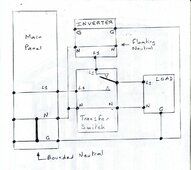再生可能 エネルギー
New Member
- Joined
- Nov 28, 2019
- Messages
- 261
I would like to build a Switch Device to connect a 240V load to either:
- the Grid or
- a Split-Phase Inverter (which is not Grid connected).
I plan to use a separate 2 poles relay to connect the load to one of the power input.
This part is straight forward, but regarding the Neutral and the Ground connection,
since my Split-Phase Inverter is not connected to the Grid, I think that some isolation relays
should also be used, but I could not find this information anymore, so I have few questions:
- About the Neutral wire:
1. Should the Neutral of the Grid, the Neutral of the Inverter, and the Neutral of the Load be connected all together all the time, or
2. Should the Neutral of the Load be connected either to the Neutral of the Grid or to the Neutral of the Inverter using a relay?
- About the Ground wire:
3. Should the Ground of the Grid, the Ground of the Inverter, and the Ground of the Load be connected all together all the time, or
4. Should the Ground of the Load be connected either to the Neutral of the Grid or to the Neutral of the Inverter using a relay?
So what would be your recommendation?
- the Grid or
- a Split-Phase Inverter (which is not Grid connected).
I plan to use a separate 2 poles relay to connect the load to one of the power input.
This part is straight forward, but regarding the Neutral and the Ground connection,
since my Split-Phase Inverter is not connected to the Grid, I think that some isolation relays
should also be used, but I could not find this information anymore, so I have few questions:
- About the Neutral wire:
1. Should the Neutral of the Grid, the Neutral of the Inverter, and the Neutral of the Load be connected all together all the time, or
2. Should the Neutral of the Load be connected either to the Neutral of the Grid or to the Neutral of the Inverter using a relay?
- About the Ground wire:
3. Should the Ground of the Grid, the Ground of the Inverter, and the Ground of the Load be connected all together all the time, or
4. Should the Ground of the Load be connected either to the Neutral of the Grid or to the Neutral of the Inverter using a relay?
So what would be your recommendation?




